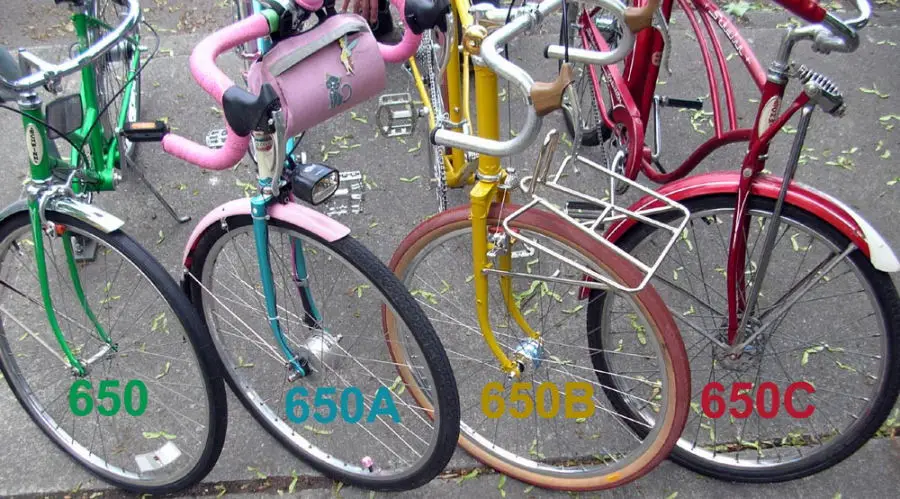
|

There is much confusion in bicycle tire sizing, and much of it results from talking in "shorthand." For example, you might think that "26 inches" was a tire size, but it is not!
There are no fewer than 5 different, incompatible "26 inch" sizes which you are likely to encounter. And one of them is even sometimes called a 27-inch size! A so-called "26 inch" wheel/tire could have an ISO rim size of:
The traditional sizing systems are based on a measurement of the outside diameter of a tire. This would usually be measured in inches (26", 27", etc.) or millimeters (650, 700, etc.). A second number or letter code would indicate the width of the tire. (26 x 2.125, 27 x 1 1/4...650B, 700C...)
Unfortunately, evolution of tires and rims has made these measurements lose contact with reality. Here's how it works: Let's start with the 26 x 2.125 size that became popular on heavyweight "balloon tire" bikes in the late '30's and still remains common on "beach cruiser" bikes. This size tire is very close to 26 inches in actual diameter. Some riders, however were dissatisfied with these tires, and wanted something a bit lighter and faster. The industry responded by making "middleweight" tires marked 26 x 1.75 to fit the same rims. Although they are still called "26 inch", these tires are actually 25 5/8", not 26". This same rim size was adopted by the early pioneers of west-coast "klunkers", and became the standard for mountain bikes. Due to the appetite of the market, you can get tires as narrow as 25 mm to fit these rims, so you wind up with a "26 inch" tire that is more like 24 7/8" in actual diameter -- also "fatbike" tires more than 4 inches wide, with an outside diameter more like 27 inches!
![]()
![]()
Note that the inch-based designations sometimes express the width in a decimal (26 x 1.75) and sometimes as a common fraction (26 x 1 3/4). This is the most common cause of mismatches. Although these size designations are mathematically equal, they refer to different size tires, which are NOT interchangeable. It is dangerous to generalize when talking about tire sizing, but I would confidently state the following:
The key ISO/E.T.R.T.O. dimension is a three digit number known as the "Bead Seat Diameter". This is the smallest diameter of the tire inside the rim, and the diameter of the little shelf ("bead seat") inside each flange of some rims.. "26 inch" tires will have ISO/E.T.R.T.O Bead Seat Diameters of 559 mm, 571 mm, 584 mm, 590 mm or 597 mm.
If you want more detail on the arcana of Bicycle Tire Sizing, click here.
The Canadian 26 x 1 1/2 F.12 size is generally interchangeable with the Schwinn version.
Various attempts were made to popularize it in the U.S., by Schwinn and Raleigh in the 1980s, and by Rivendell and other high-end builders in the 2000s. As of 2015, this size has finally caught on and tires are widely available, thanks to the recognition that tires 32mm - 47mm wide (depending on weight load) at moderate air pressure offer a far more comfortable ride than skinnier tires at high pressure -- and without increasing rolling resistance. The slightly smaller diameter than with the traditional, narrower 622 mm (700C) road tire also allows the top tube of the frame to be shorter to accommodate a shorter rider, without toe-clip interference.
See also my Article: 650B (584 mm) Conversions for Road Bikes
Wide, knobby tires are also offered in the 584 mm bead seat diameter, and marketed as "27.5" tires, the same way wide, knobby 622mm tires are marketed as "29ers". "27.5" tires are useful for off-road riders who need a smaller bicycle than is possible with "29ers" but can ride a larger one than with traditional 559 mm off-road tires. The marketing concept is that "27.5" is halfway between 26 and 29. The tire size isn't exactly halfway in between -- do the math if you like -- and the name suggests that this is a new tire size when it isn't!
The 590 mm size has fallen out of fashion since the advent of the mountain bike in the late 1970s, but there are still lots of bikes on the road that use it. It remains fairly popular in Japan.
A reasonable person would expect that any "26 x 1 3/8" tire would fit any "26 x 1 3/8" rim, but that is not the case, if one of them is Schwinn size and the other is English size.
The 597 mm size was also formerly used on high-end British "club" bicycles, with the marking "26 x 1 1/4 E.A.1" That size was pretty much abandoned in Britain in the late 1950s, when the 630 mm (27 inch) size replaced it.
The 26 x fraction sizes also have French designations. We thank Aaron Goss of Aaron's Bike Repair for the photo below. See our article on 650B tires for more about these sizes, and Sheldon's conversion of a bicycle from 622mm (700C) to 584mm (650B, 26 x 1 1/2") wheels.

![]()
![]()
![]()
![]()
Last Updated: by Harriet Fell